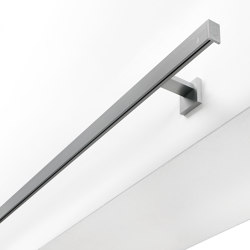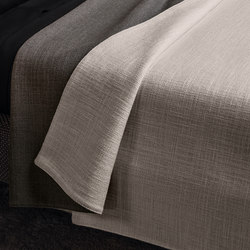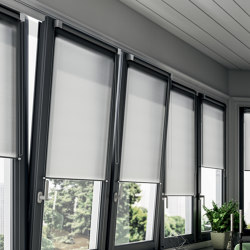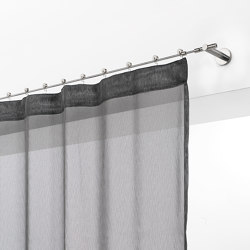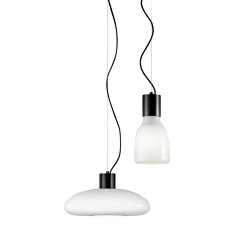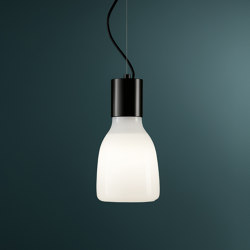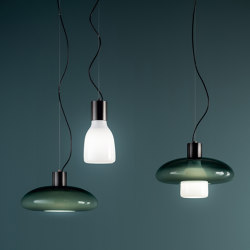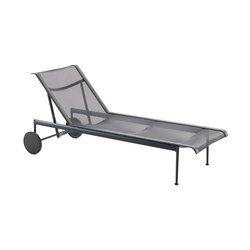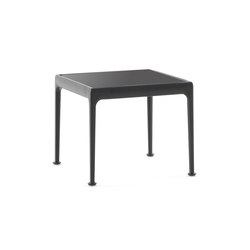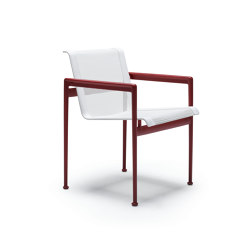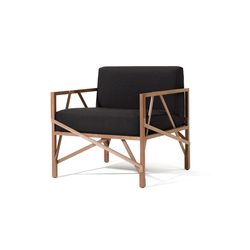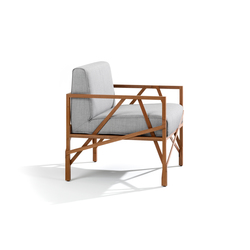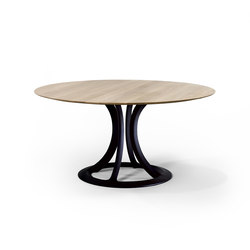Sobre Svenskt Tenn
DESCUBRE MáS SOBRE SVENSKT TENN
Josef Frank and Estrid Ericson admire Josef Frank’s "Primavera" pattern. (Photo: Gösta Glase)
SVENSKT TENN – A lifestyle company since 1924
Svenskt Tenn is a company that has strong ties with its roots; in particular the legacy inherited from the founders, Estrid Ericson and designer Josef Frank.
Frank’s timeless design and Estrid Ericson’s artistry and power of innovation form the foundation of the interior design philosophy embodied by Svenskt Tenn.
“There’s nothing wrong with mixing old and new, with combining different furniture styles, colours and patterns. Anything that is in your taste will automatically fuse to form an entire relaxing environment. A home does not need to be planned down to the smallest detail or contrived.; it should be an amalgamation of the things that its owner loves and feels at home with.”
(Josef Frank, from an article in the design magazine Form in 1958).
”Never let things stay permanent in your home – keep rearranging the furniture, and remember to leave space for children and gifts. Your home will thereby remain a living entity.”
(Estrid Ericson in an excerpt from an article in design weekly Heminterior on tips for newlyweds).
Josef Frank and Estrid Ericson at the drawing board at Svenskt Tenn 1964 (Photo: Lennart Nilsson)
So very much more than a unique interior design store!
Only the very best and most original thoughts, ideas and creations have the strength and might to survive their originators and give rise to new schools, new cultures and new concepts. This is especially true of artistic creativity in general and interior design in particular. For 80 years, Svenskt Tenn has been one such rare and original concept - a school of its own with a following that extends far beyond our Swedish borders.
In purely physical terms, of course, Svenskt Tenn is first and foremost our classic store on Stockholm’s elegant waterside boulevard, Strandvägen. It’s home to an extensive and richly varied collection of modern classics ranging from furniture, textiles, lamps and glass to porcelain and other interior décor objects.
As a concept, however, Svenskt Tenn represents so very much more than these wonderful objects could ever, even collectively, achieve. Svenskt Tenn is an idea, a lifestyle, a philosophy and an ideal – a distinct culture in its own right.
This culture was established by the lady who created Svenskt Tenn back in the 1920s, Estrid Ericson*, and was later refined and honed to perfection during her 33 year’ artistic collaboration with urban planner, architect and designer Josef Frank. Frank was Austrian which is somewhat paradoxical as this man is considered to be the most influential artist in Swedish interior décor in modern times, quite possibly the most influential ever.
As a team, Estrid Ericson and Josef Frank were able to develop an exuberant, lavish and imaginative style, fearlessly drawing inspiration from a multitude of cultures and periods and fusing these impressions into their own personal world of timeless beauty and expression.
This is the unique legacy we have inherited at Svenskt Tenn today. We mean to preserve and nuture this gift, and prepare it to face the modern challenges of tomorrow.
The timeless quality of this heritage is best demonstrated by the recent growing interest in Svenskt Tenn among young people throughout the world. The survival of the fittest applies here too - only the very best survive the test of time!
80 years dedicated to beauty
Svenskt Tenn was opened in October 1924 by Estrid Ericson, a thirty-year-old art teacher, and Nils Fougstedt, an established pewter artist. The premises were small, housing a store and a workshop on Smålandsgatan in central Stockholm. Estrid had recently given up her job as an art teacher and was working at the reputable interior design firm Wikman & Wiklund. It was there that she met Fougstedt, who first aroused her interest in pewter, which was very much in vogue at the time.
As the name implies, Svenskt Tenn (Swedish Pewter) initially sold only pewter objects – artistic pieces designed by Fougstedt and other contemporary designers, and not least by Estrid Ericson herself. Estrid also managed the store, and Svenskt Tenn rapidly became an established and highly appreciated store among Stockholmers. Accordingly, Estrid Ericson’s own good name and reputation also grew as she received press acclamation for her creativity and talent, as well as her lively imagination and genuine sense of beauty.
In 1925, just one year after opening its doors, Svenskt Tenn made its breakthrough. Beautiful, modern pewter pieces, all stamped with the firm’s angel hallmark, were displayed at exhibitions in Europe and America, and Svenskt Tenn was awarded a gold medal at the World Exhibition in Paris.
Estrid Ericson soon earned a reputation not only for her artistic talent, but also as a resolute and determined businesswoman. By 1927, she had already decided, in a bold move, to relocate her store to larger premises on Strandvägen, one of Stockholm’s most fashionable boulevards for leisurely waterside strolls - despite the fact that several people in her immediate entourage advised against it.
From pewter to furniture, from neoclassicism to functionalism
Svenskt Tenn was founded at a time when neoclassicism and the 1920s’ ideals of worldly elegance and exoticism were still forces to be reckoned with. By 1925, however, Estrid Ericson was already starting to explore the world of functionalism. When she decided to renovate her Strandvägen home, at the top of the building that still houses Svenskt Tenn, she commissioned a whole new range of furniture from a functionalist architect, Uno Åhrén, who had also designed her store. The work on her apartment inspired Estrid Ericson to open an interior design department at Svenskt Tenn, collaborating with both Åhrén and another young architect, Björn Trägårdh. Carpenters and upholsterers were engaged as Svenskt Tenn began to develop its own range of furniture and an interior design collection. The product range still included pewter, but these pieces gradually came to play a lesser role as time went by.
Svenskt Tenn’s furniture was exhibited for the first time in 1931 at Galleri Modern in Stockholm, meeting with tremendous success. It had taken Svenskt Tenn just six years to evolve from a small pewter studio into Stockholm’s most fashionable interior design store. By 1930, the Svenskt Tenn brand name was considered to be so widely recognised and valuable that Estrid Ericson decided to retain it, even though both the company and its operations had undergone such radical changes.
It is worth noting that during its initial “functionalist period”, Svenskt Tenn was considered the very height of modernism and even radicalism in Swedish interior design circles. Prince Sigvard Bernadotte, Sweden’s “designer Prince”, had his room at the Stockholm Palace redecorated in 1932 with furniture from Svenskt Tenn. The severe, minimalistic room with its black, white and dark blue colour scheme caused a sensation in designer circles, not to mention consternation at Court!
The beginning of the Josef Frank era
So Estrid Ericson had begun her career as a neo-classicist, but as an artist sensitive to the winds of change, she was also one of the first people in Stockholm to take an active interest in functionalism. Those who are familiar with today’s Svenskt Tenn may find her functionalist creed – as formulated in an interview in 1932 – somewhat alien: “Everything in the room should be sober and elegant. I adhere rigidly to a belief in neutral colours when it comes to interior décor for the home. A room should feel tranquil and orderly, and there should be no excesses of colour. The floors should be beige like sand, brown like earth, or green like grass.”
It can hardly be denied that this sounds like a complete contradiction of all that Svenskt Tenn has since come to represent.
The root of Estrid Ericson’s and Svenskt Tenn’s swift abandonment of rigid functionalist principles in favour of today’s lavish, exuberant and limitless style can be summed up in a single name – Josef Frank.
Austrian architect Josef Frank (born in 1885) was one of the front-line figures of Viennese modernism – a movement that in many ways still bore a strong resemblance to neoclassicism. By the early 1920s, however, Frank had already begun to question the doctrinaire ideals of emerging modernism, developing instead his own unique style and aesthetic philosophy, where values such as humanity, convenience, congeniality, elegance, colour and genuine aesthetic stimulation outweighed modernist principles.
Estrid Ericson had discovered Josef Frank’s work back in 1925, by which time Frank had already designed the first of his famous villas in Falsterbo, southern Sweden. She placed her first order for his furniture in 1932 and their collaboration soon intensified. In 1933, Josef Frank, who was married to a Swedish lady, emigrated to Sweden to escape the advancing Nazism.
Josef Frank’s sophisticated and original furniture design - with its modernist features and its roots in classicism and Viennese elegance, and with its English and Far-Eastern influences – soon ousted Uno Åhrén’s and Björn Trägårdh’s stricter modernist pieces from the Svenskt Tenn product range. As so often before, Estrid Ericson demonstrated her independent thinking and constant willingness to develop and change.
Stylistically speaking, Estrid Ericson and Josef Frank were initially poles apart, representing as they did opposing ideals. They did, however, share several crucial attributes – their fearless independence, their fundamental feeling for timeless quality and their interest in oriental arts and handicrafts, and architecture. They almost instantly struck up an artistic relationship that was to withstand the tests of time and intensify for 33 years until Frank’s death in 1967. Estrid Ericson soon adopted Josef Frank’s free and humanistic interior design philosophy, which contrasted sharply with modernist doctrines and advocated that the home should be a congenial place in which harmony and comfort are created with bold contrasts in the choice of design and textiles.
Svenskt Tenn provided Josef Frank, who was 50 by the time he entered the firm, with a unique arena from which to develop his imaginative and complex artistic talent. He also had Estrid Ericson by his side to serve as innovative set designer and as a constant source of inspiration. Their joint legacy is one of Sweden’s cultural treasures whose value has continued to appreciate with time.
Swedish Modern
The breakthrough for the “new” Svenskt Tenn came in 1934, the year that Josef Frank joined the firm, with an exhibition at Liljevalchs featuring a living room designed by Estrid Ericson using Josef Frank’s furniture. Svenskt Tenn’s international breakthrough came at the World Exhibitions held in Paris in 1937 and in New York in 1939. Svenskt Tenn’s showcased rooms attracted considerable attention and were a major influence in the international coining of the “Swedish Modern” concept, which made its first appearance in Paris and later became firmly established in New York.
1934 is a celebrated year in Svenskt Tenn’s history. A whole new department designed by Frank was opened at the expanded premises on Strandvägen. The store also opened its now world-famous textile department, with fabrics selected by Estrid Ericson from all over the globe. This department would later focus primarily on Josef Frank’s own brilliant collection of textile prints – which remain Svenskt Tenn’s principal hallmark today.
A new era begins with Ann Wall
Following the death of Josef Frank in 1967, Estrid Ericson continued to run Svenskt Tenn until 1975, when she sold the company to The Kjell and Märta Beijer Foundation (Kjell och Märta Beijers stiftelse). Estrid went on working with the firm on a daily basis and remained living in her apartment on Strandvägen until her death in 1981. During the latter years of her life, she finally returned to pewter design and created some of her most beautiful pewter pieces.
In 1979, Ann Wall took over the helm at Svenskt Tenn and was to spend the next 20 years working on the business concept she herself had coined: preserving the legacy and spirit of Estrid Ericson and Josef Frank in a modern form. It was under Ann Wall that the company underwent the thorough modernisation it so badly needed. Estrid Ericson had run Svenskt Tenn with the help of antiquated administrative and financial systems and routines that needed an extensive overhaul. Towards the end of Estrid Ericson’s period at the helm, Svenskt Tenn was making a loss, but it now became a well-run modern company that posted excellent profits year after year. Major investments were also made in the staff. One of the many improvements involved giving them the opportunity to gain work experience abroad, which benefited both the employees and Svenskt Tenn’s international standing. It was also under the leadership of Ann Wall that Svenskt Tenn began to market itself in the true sense of the word.
Another important and lasting initiative launched under Ann Wall’s leadership was the endeavour to attract new target groups to Svenskt Tenn – primarily among the younger generation, but also from new social groups and abroad. This rejuvenation process, which was introduced with great sensitivity, was successfully carried out by launching new designers and collaborating with art and design schools etc. Throughout the 1980s and 1990s, Svenskt Tenn was one of the main arenas for the emerging new Swedish design trend that has attracted so much worldwide attention in recent years. The careful renewal of the product range was harmonised and co-ordinated with both the window displays and marketing. One crucial aspect of the marketing and brand building involved exhibition activities, a field in which Ann Wall proudly continued in the footsteps of her predecessor Estrid Ericson. Ann Wall initiated a long-term collaboration with architect and interior designer Anki Linde, who was responsible for dressing Svenskt Tenn’s windows and preparing many of its exhibitions at the gallery on Strandvägen, as well as elsewhere in Sweden and abroad.
The highlight of Ann Wall’s and Anki Linde’s artistic collaboration was their famous “White Exhibition” (Vita utställningen) in 1999, the year in which Ann Wall also resigned as Managing Director. Another highlight was the major Josef Frank exhibition, “Warning for Good Taste” (Varning för god smak), at Kulturhuset in 1998, when Stockholm was the Cultural Capital of Europe.
“I consider that to be our most significant exhibition,” says Ann Wall. “Svenskt Tenn finally managed to rid itself of its ‘posh’, ‘bourgeois’ stamp.”
To celebrate Ann Wall’s long and highly successful term of office, Svenskt Tenn’s owners decided in 1999 to launch the Ann Wall Design Prize (see separate article), which is awarded every year to a talented young designer with a view to promoting the role of design in society at large.
An even more important part of Ann Wall’s legacy was the fact that under her management, Svenskt Tenn developed into a modern and effective international brand equipped to face a new age. She succeeded in the difficult task of applying the thoughts, ideas and aesthetic ideals of Estrid Ericson and Josef Frank to create a company that is both modern and timeless - one of only a handful of companies to have earned the honour of being called a “commercial cultural institution”.
The Ann Wall Design Prize
Svenskt Tenn’s owners, The Kjell and Märta Beijer Foundation, founded the Ann Wall Design Prize in 1999. It was named after the company’s long-serving Managing Director, Ann Wall, who resigned from her position that year. The prize is part of the Foundation’s efforts to promote, among other things, the preservation of the cultural and artistic values of the Swedish design and décor tradition. This prize, hoped Ann Wall, would both reward and draw attention to young designers and educational institutions active in promoting the role of design in society at large. The prize is also a means for Ann Wall to honour the ideals and visions of Estrid Ericson and Josef Frank and introduce them to a whole new generation.
“An orchid in a wintry landscape”
Estrid Ericson was born in 1894 in Hjo, where her father owned Badhotellet (The Bath Hotel) and worked as a restaurateur. She qualified as an art teacher at Stockholm’s Tekniska skolan, now the University College of Arts, Crafts and Design (Konstfack). After completing her studies, she spent a term working as an art teacher in her hometown of Hjo, but then decided to move back to Stockholm. She found a job at Svensk Hemslöjd (Swedish Handicraft) and later at the reputable interior design firm Wikman & Wiklund, a job that led to her first encounter with pewter artist and designer Nils Fougstedt.
She began to take a genuine interest in pewter craftsmanship, and when she inherited a small sum of money in 1924, she used it to rent a workshop on the island of Kungsholmen in Stockolm, which she shared with Fougstedt. By that autumn, they had already managed to expand, and Firma Svenskt Tenn opened for business in new premises that housed both a store and a workshop on Smålandsgatan in Stockholm. “When I started Svenskt Tenn, I was neither very worldly nor very practical. I relied entirely on the rather precarious future of good taste,” she wrote a few years later.
As a pewter artist and designer, Estrid Ericson gained immediate recognition for her vivid imagination and perfect taste. She also soon emerged as an ambitious, bold and resolute businesswoman. Svenskt Tenn’s rapid progress from a small pewter studio to Stockholm’s most elegant and reputable interior design store – all within a period of a few years – was proof, if any were needed, of her fearless initiative and entrepreneurial spirit. Her stylistic journey – moving as it did from neoclassicism through minimalist functionalism to its “ultimate” expression in her free and versatile collaboration with Josef Frank, once again in the space of a few short years – also demonstrated her unusual openness, confidence, fearlessness and sense of timing.
Estrid Ericson & Josef Frank
Over her 33-year-long partnership with Josef Frank, Estrid Ericson’s roles varied from that of commissioning client and corporate executive to her main role as a highly skilled interior designer and room creator. Estrid Ericson was quick to adopt Frank’s interior design philosophy - that homes should be decorated with furniture that is lightweight and easy to move, among other things. Another of Frank’s fundamental ideas was that “disorder” should rule the home – that beautiful and even ugly objects endowed with significance and “magic” should be freely combined and contrasted with a view to creating a “harmony of contradictions”. Estrid Ericson fused these ideas with her own in her “Heminredningskatekes” (Catechism of Interior Design) written in 1939.
Estrid Ericson referred to herself as Josef Frank’s “most diligent disciple”. At the same time, she was also intensely aware of her own talent and significance. Few people have had such an influence on Swedish interior design as Estrid Ericson.
Freedom and imagination, harmony through contrasts
Imagination, playfulness, freedom of thought, unerring good taste and an instinct for beauty and quality – these are just some of the distinctive features of Estrid Ericson’s interiors. She drew inspiration from everything around her - the countryside, the books she read and particularly her travels, which mainly took her to England, France and her favourite country, Italy. China and the Far East also remained important sources of inspiration throughout her career, and she took a great interest in South American and African handicrafts. Estrid Ericson had the rare ability to recognise the beauty in things that others overlooked, and knew how to combine and contrast these simple things with furniture and objects whose origins, designs and temperaments could vary enormously. She was a dedicated collector with a particular passion for collecting much-loved objects from all over the globe that she displayed in Frank’s elegant display cabinets.
Alongside the Svenskt Tenn store on Strandvägen, her own apartment at the top of the same building and her summer house, Tolvekarna, in Tyresö outside Stockholm, also served as ever-changing arenas for Estrid Ericson’s experimentation. On Monday mornings, she would come in from Tolvekarna with huge armfuls of flowers, foliage and twigs. Using her perfect sense of style, she would then proceed to arrange them boldly in the front windows and inside the store, preferably combining them with plastic flowers and other unusual, even drastic, decorative features.
Harmony by contrasts is one of the fundamental concepts of the interior design philosophy of both Estrid Ericson and Josef Frank. They shared the conviction that beautiful objects can be placed together, no matter from where or which periods they stem. Estrid Ericson was always keen to combine elements from all over the globe in her interiors, and she was particularly fond of world maps, which she used as recurring interior décor features. The botanical world was another constant source of inspiration to her. Botanical prints were used as decorative elements and remain one of her most typical hallmarks. Another is her use of mirrors to create the illusion of greater space in smaller rooms. Yet another of the many talents that she developed into a fine art was that of table setting. She set wonderfully varied and imaginative tables to suit any style and temperament, and they soon became major attractions at Svenskt Tenn.
A legacy that lives on
As store manager and corporate executive, Estrid Ericson was resolute and commanded respect. She could sometimes appear austere and reserved, even stern, but behind this façade she hid great warmth, compassion and humanity. She ran Svenskt Tenn for half a century with foresight, strength and consistency, expanding the company from a small pewter studio into a global interior design brand in the broadest sense of these words.
After Estrid Ericson sold Svenskt Tenn to The Kjell and Märta Beijer Foundation in 1975, she continued to work with the firm until her death in 1981. During the latter years of her life, she finally returned to pewter design, and created some of her most beautiful pewter objects.
Towards the end of her life, Estrid Ericson also expressed concerns about what might happen to her life’s work once she was gone. She mourned the fact that she had no children to follow in her footsteps. All of us at Svenskt Tenn today hope and believe that Estrid Ericson can now look down from above and see that her fears were groundless and that her life’s work lives proudly on, stronger than ever before!
Josef Frank “I created the Scandinavian style”
Josef Frank was born in 1885 and grew up in Vienna at the heart of the Austro-Hungarian Empire. He studied architecture at the University of Technology in Vienna, and immersed himself in classical architectural theory, which held that modern expressions must always be rooted in history, and particularly in antiquity. This fundamental classical schooling, and the grounding it gave him in architectural history, were to interact throughout Frank’s career with his own highly personal interpretation of modernism.
In the early 1900s, Vienna was one of the architectural capitals of Europe and Josef Frank soon numbered among the emerging pioneers of functionalism, together with architects such as Otto Wagner, Josef Hoffman and particularly Adolf Loos, who had a major influence on Frank. By 1914, Frank was already designing his first houses with flat roofs and round windows. (During the 1920s, he designed several famous villas of similar ilk that were built in Falsterbo in southern Sweden). He also took an active interest in social issues, designing modern orphanages and bright, functional homes for the working class, among other things. By 1927, Frank was one of the biggest names at the “Die Wohnung” exhibition in Stuttgart, which marked the international breakthrough of functionalism and proved to be the predecessor of the Stockholm Exhibition held later in 1930.
The break with modernism – and Austria
Josef Frank was, however, quick to turn his back on the strict and doctrinaire definition of modernism given by Le Corbusier and Bauhaus. His free, lavish interiors with relaxing sofas and flowery cushions, designed for comfort and congeniality, soon led him to break away from Le Corbusier and Bauhaus.
Josef Frank had already begun to design furniture for his own interiors back in 1910. As a furniture designer, his style stemmed from so-called Viennese grace and elegance, although Frank was also heavily influenced by England. Other important sources of inspiration were ancient Greece and Rome, as well as China and Japan. According to Frank’s interior design philosophy, the walls of a room should be white and the furniture should be lightweight and easy to move (Windsor chairs, for example, should be light enough to lift with a single finger). No furniture or interior details should be designed or created for a specific room or form part of the room’s architecture. Rather, the interior should be flexible and easy to alter and adapt to changing requirements. Cupboards should not be fixed to the walls but stand alone on high legs to reveal the contours of the room. Ceiling lighting was out of the question - rooms should be lit with lightweight, functional floor and wall lamps.
Josef Frank’s first encounter with Estrid Ericson took place at the end of the 1920s. Their collaboration began in 1932, when Estrid Ericson commissioned her first furniture for Svenskt Tenn from Frank. In 1933, Frank, who was married to a Swedish lady, Anna (née Sebenius), emigrated to Sweden and Stockholm to avoid the advancing Nazism. Frank became, as his writer-friend Eva von Zweigbergk so drastically put it in his obituary, “Hitler’s gift to Sweden”.
33 years at Svenskt Tenn
At Svenskt Tenn, Josef Frank, who turned 50 on his arrival in Sweden, found a unique arena for his artistic talent and aesthetic philosophy. Over his 33-year-long partnership with Estrid Ericson, he was given the peace and freedom to develop and perfect his visions. During this lengthy latter part of his career, Frank devoted himself primarily to furniture and interior design, while his ideas for houses sadly remained on the drawing board.
Svenskt Tenn’s archives contain no fewer than 2,000 furniture designs by Josef Frank, 70 of which are currently in production. This is a Swedish cultural treasure trove whose value only continues to grow as Frank’s designs go on gaining new followers among younger generations in large parts of the world. Frank’s timeless furniture classics, always manufactured by highly skilled craftsmen using only the very best materials to ensure top quality, have an enduring value and often feature in both Swedish and international quality auctions.
The question is, however, whether Josef Frank could actually be best known for his textile patterns. These patterns, painted by Frank in watercolours - originally printed in England but as of the 1940s by Erik Ljungberg in Floda, Sweden - gave him the opportunity to express his exuberant imagination, his artistic talent and his masterly instinct for colour and shape. Svenskt Tenn’s archives contain no fewer than 160 patterns designed by Frank, 50(!) of which were sent as a birthday present to Estrid Ericson on her 50th birthday, all of them produced during an intensely creative period during the war, when Frank temporarily moved to New York. Frank’s fabrics have become such modern classics in Sweden that our contemporary eyes may have trouble recognising their boldness and radicalism in terms of colour scheme, design and choice of motif, hovering as they do somewhere between realism, surrealism and fantasy.
“I have saved Swedish interior design”
In recent years, the Austrian Josef Frank has increasingly been recognised as quite possibly Swedish interior design’s most important figure ever. It may seem somewhat paradoxical that Josef Frank, a central European whose roots lay in Viennese elegance and who abandoned minimalism and doctrinaire modernism, should have developed a style that came to be known internationally as “Swedish Modern”.
As a person, Josef Frank was often described as a quiet and serious man. He was thoughtful and rarely made sweeping statements. This is why everyone around him was so surprised, not least Estrid Ericson herself, when, in reply to a question she asked on behalf of a journalist who wanted Josef Frank’s personal opinion of what he had meant to Sweden, he replied:
“I have saved Swedish interior design in its entirety and created the Scandinavian style. I build on a tradition. Before my contribution, the only source of inspiration was Bauhaus.”
This statement may not be particularly humble, but it is nevertheless hard to contradict…
Estrid Ericson & Josef Frank - Artistic symbiosis
The collaboration between Estrid Ericson and Josef Frank lasted 33 years and was one of those rare and fortunate artistic partnerships in which two strong and highly creative temperaments were able to fuse and produce something much greater than the sum of their respective talents. Those who knew them describe their relationship as a form of artistic symbiosis. They understood each other from the word go and never felt the need to explain themselves.
Estrid Ericson was quick to adopt Josef Frank’s complex and highly personal interior design philosophy and aesthetic ideals, even though they often contradicted her own previous beliefs. For more than three decades she ensured that this mature phase of Frank’s career provided him with a unique arena suited to his artistic creativity. For his part, Frank did everything to ensure that his designs truly expressed all of Estrid Ericson’s interior decorating ideas. As a mutual friend of theirs once defined it: “He did what she asked him to do, and she approved everything he did.”
Estrid Ericson first encountered Josef Frank and his architecture and interior design firm, Haus und Garten, in Vienna back in the mid-1920s, perhaps even earlier. In 1921, while staying with good friends, she had seen some dining-room furniture that appealed to her. It was designed by Josef Frank. In 1925, they both took part separately and successfully in the World Exhibition in Paris, where Estrid Ericson earned a gold medal for her pewter objects, while the rooms designed by Frank attracted considerable attention, particularly among Swedish modernists. They began their collaboration in 1932 when Frank received his first order from Svenskt Tenn. In 1933, Frank and his Swedish wife Anna moved to Stockholm. The following year, Frank joined Svenskt Tenn, replacing Uno Åhrén as the firm’s principal designer.
Immediate success and breakthrough
The breakthrough for what was to be an artistic partnership that marked the start of an era came as early as 1934, at an exhibition at Liljevalchs. Svenskt Tenn’s exhibit was a living room designed by Estrid Ericson that contained new furniture created by Josef Frank. It made both the public and the critics gasp in wonder. A completely new, rich and lavish spirit had emerged. True, traces of Viennese elegance could be discerned, but they were overshadowed by the sensational upholstered furniture with their English influences. Teak and mahogany had replaced birch wood. There were round tables with travertine and green marble tops, and a leopard skin lying in front of an open bar cabinet. Frank’s now classic floor lamps were of Viennese 1920s’ design, while between the windows hung one of Estrid Ericson’s special hallmarks, the round mirror.
The room boasted an air of exoticism and lavishness that contrasted glaringly with co-exhibitor Carl Malmsten’s austerely furnished rooms, with their stylistic roots in Swedish nature and tradition. The luxurious elegance of this room marked a confident and conscious departure from what Josef Frank himself termed “Swedish arts-and-crafts mundanity.” The risk that the magnificently oversized upholstered furniture might be perceived as “over the top” was countered by the supremely elegant and graceful lines.
Svenskt Tenn’s new elegance met with immediate success. In 1934, the same year as the exhibition at Liljevalchs, a new department opened one floor up at the Strandvägen store. Its interior was designed by Frank, and included a series of rooms in which Estrid Ericson’s and Josef Frank’s interior design style – a humanised and lavish form of functionalism designed for comfort, well-being and congeniality, featuring harmony based on imaginative contrasts – had already reached full bloom. The foundations had now been laid for today’s Svenskt Tenn.
When they first became acquainted, Estrid Ericson and Josef Frank represented very different stylistic ideals. They did however also have a great deal in common. They both made uncompromising demands on the very highest quality in all areas, and both were inspired by the aesthetic principles and traditions of different cultures and periods. Literature was another important source of inspiration they shared. They were united in a relationship based on mutual respect and admiration. In private, their tone was courteous and formal, although it gradually became less formal as the years went by. It took several years, for example, before they stopped calling each other “Miss Ericson” and “Professor Frank” and addressed each other as Estrid and Pepi – Frank’s pet name among those with whom he was intimate.
Together, Estrid Ericson and Josef Frank created a totally personal interior design culture whose fundamental principles were based on an open, free, lavish and tolerant lifestyle. Nobody has formulated this stylistic ideal better than Josef Frank himself in an article in Svensk Form (Swedish Design): “The home should not primarily be an efficient machine, it should provide comfort, relaxation and conviviality. It should be restful to the eyes and revive the senses. There is no room for puritanical principles in good interior design.”
The distinct style of Svenskt Tenn
The unmistakeable Svenskt Tenn style, created by Estrid Ericson and Josef Frank and later sensitively cultivated and refined over many years, is based on a free and tolerant lifestyle and a genuine love of all that is beauty and quality. Its inspiration is drawn from all corners of the world, from a variety of cultures and periods, and fuses all these images and impressions into a wholeness in which tranquillity and harmony are achieved through often dramatic contrasts – in design, colour, pattern and material.
Josef Frank formulated his interior design philosophy – which Estrid Ericson later adopted as her own – in a much quoted article that appeared in Form magazine in 1934: “The modern dwelling space has white walls. This is the only way to preserve its freedom and enable the introduction of a variety of items without disrupting the colour scheme,” he wrote. “In the modern dwelling space, disorder rules; there is, in other words, no furniture made for a specific location.”
According to Frank’s interior design philosophy, all items of furniture should be lightweight and easy to move. They should never form part of the room’s architecture, but instead be easy to move around to suit personal taste and current needs. Cupboards and other storage furniture should stand on high legs to ensure that the room’s contours “are visible, with no interruption, in their entirety.” The room should have no ceiling lighting, but be lit with conveniently placed floor and wall lamps that are easy to move. It should be easy to adapt and refine the décor to the various stages of life and their corresponding requirements. As Estrid Ericson wrote in her text, Interior Design Tips for Newly-weds: “Never let things become permanent in your home – keep rearranging the furniture, and remember to leave space for children and gifts. Your home will thereby remain a living entity.”
One of Josef Frank’s fundamental ideas was also his view that the occupants of a home should enjoy a personal relationship with all the objects surrounding them. Each object should hide a “secret” that makes it special and interesting. All pieces of furniture should be individual “living organisms” with “souls” of their own.
Svenskt Tenn’s typical interior designs are holistic. They create harmony and “magic” not by using the stern and austere compositions of classic modernism, but by freely and imaginatively, almost excessively, combining furniture and objects in different materials, with different designs and colour schemes borrowed from different cultures and periods, and using Frank’s gloriously colourful textile patterns as their unifying element.
“There’s nothing wrong with mixing old and new, with combining different furniture styles, colours and patterns. The things that you like will automatically fuse to form a harmonious and relaxing environment. A home does not need to be contrived or planned down to the tiniest detail; it should be an amalgamation of the things its owner loves and feels at home with,” wrote Josef Frank in an article in Form published in 1958.
Comfort, conviviality and well-being, or joie de vivre, are the keys to this unique, timeless and lavishly functionalist style. It is a stylistic ideal that embraces the notion that good interior design should, as Josef Frank so succinctly put it, “be restful to the eyes and revive the senses”.
Svenskt Tenn today
Efforts to carefully renew and develop Svenskt Tenn to prepare the company for modern challenges is now continuing under the leadership of Yvonne Sörensen, who was appointed Managing Director in 2001. Under Yvonne Sörensen, Svenskt Tenn’s international activities have also intensified. Among other things, two highly publicised exhibitions have been held in New York, a launch has been held in Japan and other launches are being planned in other markets.
The legacy left by Estrid Ericson and Josef Frank has been preserved and remains the core of Svenskt Tenn’s body and soul. The product range is primarily based on Frank’s timeless designs, complemented with newer works by carefully selected designers and artists. Estrid Ericson’s spirit lives on at the store on Strandvägen, where our selection of classics is complemented each new season with objects acquired on purchasing trips that lead our buyers all over the globe. Estrid Ericson’s spirit also lives on in the store’s window displays, décor and exhibitions. Svenskt Tenn is and will continue to be an ever-changing arena for beauty and inspiration!
Josef Frank and Estrid Ericson admire Josef Frank’s "Primavera" pattern. (Photo: Gösta Glase)
SVENSKT TENN – A lifestyle company since 1924
Svenskt Tenn is a company that has strong ties with its roots; in particular the legacy inherited from the founders, Estrid Ericson and designer Josef Frank.
Frank’s timeless design and Estrid Ericson’s artistry and power of innovation form the foundation of the interior design philosophy embodied by Svenskt Tenn.
“There’s nothing wrong with mixing old and new, with combining different furniture styles, colours and patterns. Anything that is in your taste will automatically fuse to form an entire relaxing environment. A home does not need to be planned down to the smallest detail or contrived.; it should be an amalgamation of the things that its owner loves and feels at home with.”
(Josef Frank, from an article in the design magazine Form in 1958).
”Never let things stay permanent in your home – keep rearranging the furniture, and remember to leave space for children and gifts. Your home will thereby remain a living entity.”
(Estrid Ericson in an excerpt from an article in design weekly Heminterior on tips for newlyweds).
Josef Frank and Estrid Ericson at the drawing board at Svenskt Tenn 1964 (Photo: Lennart Nilsson)
So very much more than a unique interior design store!
Only the very best and most original thoughts, ideas and creations have the strength and might to survive their originators and give rise to new schools, new cultures and new concepts. This is especially true of artistic creativity in general and interior design in particular. For 80 years, Svenskt Tenn has been one such rare and original concept - a school of its own with a following that extends far beyond our Swedish borders.
In purely physical terms, of course, Svenskt Tenn is first and foremost our classic store on Stockholm’s elegant waterside boulevard, Strandvägen. It’s home to an extensive and richly varied collection of modern classics ranging from furniture, textiles, lamps and glass to porcelain and other interior décor objects.
As a concept, however, Svenskt Tenn represents so very much more than these wonderful objects could ever, even collectively, achieve. Svenskt Tenn is an idea, a lifestyle, a philosophy and an ideal – a distinct culture in its own right.
This culture was established by the lady who created Svenskt Tenn back in the 1920s, Estrid Ericson*, and was later refined and honed to perfection during her 33 year’ artistic collaboration with urban planner, architect and designer Josef Frank. Frank was Austrian which is somewhat paradoxical as this man is considered to be the most influential artist in Swedish interior décor in modern times, quite possibly the most influential ever.
As a team, Estrid Ericson and Josef Frank were able to develop an exuberant, lavish and imaginative style, fearlessly drawing inspiration from a multitude of cultures and periods and fusing these impressions into their own personal world of timeless beauty and expression.
This is the unique legacy we have inherited at Svenskt Tenn today. We mean to preserve and nuture this gift, and prepare it to face the modern challenges of tomorrow.
The timeless quality of this heritage is best demonstrated by the recent growing interest in Svenskt Tenn among young people throughout the world. The survival of the fittest applies here too - only the very best survive the test of time!
80 years dedicated to beauty
Svenskt Tenn was opened in October 1924 by Estrid Ericson, a thirty-year-old art teacher, and Nils Fougstedt, an established pewter artist. The premises were small, housing a store and a workshop on Smålandsgatan in central Stockholm. Estrid had recently given up her job as an art teacher and was working at the reputable interior design firm Wikman & Wiklund. It was there that she met Fougstedt, who first aroused her interest in pewter, which was very much in vogue at the time.
As the name implies, Svenskt Tenn (Swedish Pewter) initially sold only pewter objects – artistic pieces designed by Fougstedt and other contemporary designers, and not least by Estrid Ericson herself. Estrid also managed the store, and Svenskt Tenn rapidly became an established and highly appreciated store among Stockholmers. Accordingly, Estrid Ericson’s own good name and reputation also grew as she received press acclamation for her creativity and talent, as well as her lively imagination and genuine sense of beauty.
In 1925, just one year after opening its doors, Svenskt Tenn made its breakthrough. Beautiful, modern pewter pieces, all stamped with the firm’s angel hallmark, were displayed at exhibitions in Europe and America, and Svenskt Tenn was awarded a gold medal at the World Exhibition in Paris.
Estrid Ericson soon earned a reputation not only for her artistic talent, but also as a resolute and determined businesswoman. By 1927, she had already decided, in a bold move, to relocate her store to larger premises on Strandvägen, one of Stockholm’s most fashionable boulevards for leisurely waterside strolls - despite the fact that several people in her immediate entourage advised against it.
From pewter to furniture, from neoclassicism to functionalism
Svenskt Tenn was founded at a time when neoclassicism and the 1920s’ ideals of worldly elegance and exoticism were still forces to be reckoned with. By 1925, however, Estrid Ericson was already starting to explore the world of functionalism. When she decided to renovate her Strandvägen home, at the top of the building that still houses Svenskt Tenn, she commissioned a whole new range of furniture from a functionalist architect, Uno Åhrén, who had also designed her store. The work on her apartment inspired Estrid Ericson to open an interior design department at Svenskt Tenn, collaborating with both Åhrén and another young architect, Björn Trägårdh. Carpenters and upholsterers were engaged as Svenskt Tenn began to develop its own range of furniture and an interior design collection. The product range still included pewter, but these pieces gradually came to play a lesser role as time went by.
Svenskt Tenn’s furniture was exhibited for the first time in 1931 at Galleri Modern in Stockholm, meeting with tremendous success. It had taken Svenskt Tenn just six years to evolve from a small pewter studio into Stockholm’s most fashionable interior design store. By 1930, the Svenskt Tenn brand name was considered to be so widely recognised and valuable that Estrid Ericson decided to retain it, even though both the company and its operations had undergone such radical changes.
It is worth noting that during its initial “functionalist period”, Svenskt Tenn was considered the very height of modernism and even radicalism in Swedish interior design circles. Prince Sigvard Bernadotte, Sweden’s “designer Prince”, had his room at the Stockholm Palace redecorated in 1932 with furniture from Svenskt Tenn. The severe, minimalistic room with its black, white and dark blue colour scheme caused a sensation in designer circles, not to mention consternation at Court!
The beginning of the Josef Frank era
So Estrid Ericson had begun her career as a neo-classicist, but as an artist sensitive to the winds of change, she was also one of the first people in Stockholm to take an active interest in functionalism. Those who are familiar with today’s Svenskt Tenn may find her functionalist creed – as formulated in an interview in 1932 – somewhat alien: “Everything in the room should be sober and elegant. I adhere rigidly to a belief in neutral colours when it comes to interior décor for the home. A room should feel tranquil and orderly, and there should be no excesses of colour. The floors should be beige like sand, brown like earth, or green like grass.”
It can hardly be denied that this sounds like a complete contradiction of all that Svenskt Tenn has since come to represent.
The root of Estrid Ericson’s and Svenskt Tenn’s swift abandonment of rigid functionalist principles in favour of today’s lavish, exuberant and limitless style can be summed up in a single name – Josef Frank.
Austrian architect Josef Frank (born in 1885) was one of the front-line figures of Viennese modernism – a movement that in many ways still bore a strong resemblance to neoclassicism. By the early 1920s, however, Frank had already begun to question the doctrinaire ideals of emerging modernism, developing instead his own unique style and aesthetic philosophy, where values such as humanity, convenience, congeniality, elegance, colour and genuine aesthetic stimulation outweighed modernist principles.
Estrid Ericson had discovered Josef Frank’s work back in 1925, by which time Frank had already designed the first of his famous villas in Falsterbo, southern Sweden. She placed her first order for his furniture in 1932 and their collaboration soon intensified. In 1933, Josef Frank, who was married to a Swedish lady, emigrated to Sweden to escape the advancing Nazism.
Josef Frank’s sophisticated and original furniture design - with its modernist features and its roots in classicism and Viennese elegance, and with its English and Far-Eastern influences – soon ousted Uno Åhrén’s and Björn Trägårdh’s stricter modernist pieces from the Svenskt Tenn product range. As so often before, Estrid Ericson demonstrated her independent thinking and constant willingness to develop and change.
Stylistically speaking, Estrid Ericson and Josef Frank were initially poles apart, representing as they did opposing ideals. They did, however, share several crucial attributes – their fearless independence, their fundamental feeling for timeless quality and their interest in oriental arts and handicrafts, and architecture. They almost instantly struck up an artistic relationship that was to withstand the tests of time and intensify for 33 years until Frank’s death in 1967. Estrid Ericson soon adopted Josef Frank’s free and humanistic interior design philosophy, which contrasted sharply with modernist doctrines and advocated that the home should be a congenial place in which harmony and comfort are created with bold contrasts in the choice of design and textiles.
Svenskt Tenn provided Josef Frank, who was 50 by the time he entered the firm, with a unique arena from which to develop his imaginative and complex artistic talent. He also had Estrid Ericson by his side to serve as innovative set designer and as a constant source of inspiration. Their joint legacy is one of Sweden’s cultural treasures whose value has continued to appreciate with time.
Swedish Modern
The breakthrough for the “new” Svenskt Tenn came in 1934, the year that Josef Frank joined the firm, with an exhibition at Liljevalchs featuring a living room designed by Estrid Ericson using Josef Frank’s furniture. Svenskt Tenn’s international breakthrough came at the World Exhibitions held in Paris in 1937 and in New York in 1939. Svenskt Tenn’s showcased rooms attracted considerable attention and were a major influence in the international coining of the “Swedish Modern” concept, which made its first appearance in Paris and later became firmly established in New York.
1934 is a celebrated year in Svenskt Tenn’s history. A whole new department designed by Frank was opened at the expanded premises on Strandvägen. The store also opened its now world-famous textile department, with fabrics selected by Estrid Ericson from all over the globe. This department would later focus primarily on Josef Frank’s own brilliant collection of textile prints – which remain Svenskt Tenn’s principal hallmark today.
A new era begins with Ann Wall
Following the death of Josef Frank in 1967, Estrid Ericson continued to run Svenskt Tenn until 1975, when she sold the company to The Kjell and Märta Beijer Foundation (Kjell och Märta Beijers stiftelse). Estrid went on working with the firm on a daily basis and remained living in her apartment on Strandvägen until her death in 1981. During the latter years of her life, she finally returned to pewter design and created some of her most beautiful pewter pieces.
In 1979, Ann Wall took over the helm at Svenskt Tenn and was to spend the next 20 years working on the business concept she herself had coined: preserving the legacy and spirit of Estrid Ericson and Josef Frank in a modern form. It was under Ann Wall that the company underwent the thorough modernisation it so badly needed. Estrid Ericson had run Svenskt Tenn with the help of antiquated administrative and financial systems and routines that needed an extensive overhaul. Towards the end of Estrid Ericson’s period at the helm, Svenskt Tenn was making a loss, but it now became a well-run modern company that posted excellent profits year after year. Major investments were also made in the staff. One of the many improvements involved giving them the opportunity to gain work experience abroad, which benefited both the employees and Svenskt Tenn’s international standing. It was also under the leadership of Ann Wall that Svenskt Tenn began to market itself in the true sense of the word.
Another important and lasting initiative launched under Ann Wall’s leadership was the endeavour to attract new target groups to Svenskt Tenn – primarily among the younger generation, but also from new social groups and abroad. This rejuvenation process, which was introduced with great sensitivity, was successfully carried out by launching new designers and collaborating with art and design schools etc. Throughout the 1980s and 1990s, Svenskt Tenn was one of the main arenas for the emerging new Swedish design trend that has attracted so much worldwide attention in recent years. The careful renewal of the product range was harmonised and co-ordinated with both the window displays and marketing. One crucial aspect of the marketing and brand building involved exhibition activities, a field in which Ann Wall proudly continued in the footsteps of her predecessor Estrid Ericson. Ann Wall initiated a long-term collaboration with architect and interior designer Anki Linde, who was responsible for dressing Svenskt Tenn’s windows and preparing many of its exhibitions at the gallery on Strandvägen, as well as elsewhere in Sweden and abroad.
The highlight of Ann Wall’s and Anki Linde’s artistic collaboration was their famous “White Exhibition” (Vita utställningen) in 1999, the year in which Ann Wall also resigned as Managing Director. Another highlight was the major Josef Frank exhibition, “Warning for Good Taste” (Varning för god smak), at Kulturhuset in 1998, when Stockholm was the Cultural Capital of Europe.
“I consider that to be our most significant exhibition,” says Ann Wall. “Svenskt Tenn finally managed to rid itself of its ‘posh’, ‘bourgeois’ stamp.”
To celebrate Ann Wall’s long and highly successful term of office, Svenskt Tenn’s owners decided in 1999 to launch the Ann Wall Design Prize (see separate article), which is awarded every year to a talented young designer with a view to promoting the role of design in society at large.
An even more important part of Ann Wall’s legacy was the fact that under her management, Svenskt Tenn developed into a modern and effective international brand equipped to face a new age. She succeeded in the difficult task of applying the thoughts, ideas and aesthetic ideals of Estrid Ericson and Josef Frank to create a company that is both modern and timeless - one of only a handful of companies to have earned the honour of being called a “commercial cultural institution”.
The Ann Wall Design Prize
Svenskt Tenn’s owners, The Kjell and Märta Beijer Foundation, founded the Ann Wall Design Prize in 1999. It was named after the company’s long-serving Managing Director, Ann Wall, who resigned from her position that year. The prize is part of the Foundation’s efforts to promote, among other things, the preservation of the cultural and artistic values of the Swedish design and décor tradition. This prize, hoped Ann Wall, would both reward and draw attention to young designers and educational institutions active in promoting the role of design in society at large. The prize is also a means for Ann Wall to honour the ideals and visions of Estrid Ericson and Josef Frank and introduce them to a whole new generation.
“An orchid in a wintry landscape”
Estrid Ericson was born in 1894 in Hjo, where her father owned Badhotellet (The Bath Hotel) and worked as a restaurateur. She qualified as an art teacher at Stockholm’s Tekniska skolan, now the University College of Arts, Crafts and Design (Konstfack). After completing her studies, she spent a term working as an art teacher in her hometown of Hjo, but then decided to move back to Stockholm. She found a job at Svensk Hemslöjd (Swedish Handicraft) and later at the reputable interior design firm Wikman & Wiklund, a job that led to her first encounter with pewter artist and designer Nils Fougstedt.
She began to take a genuine interest in pewter craftsmanship, and when she inherited a small sum of money in 1924, she used it to rent a workshop on the island of Kungsholmen in Stockolm, which she shared with Fougstedt. By that autumn, they had already managed to expand, and Firma Svenskt Tenn opened for business in new premises that housed both a store and a workshop on Smålandsgatan in Stockholm. “When I started Svenskt Tenn, I was neither very worldly nor very practical. I relied entirely on the rather precarious future of good taste,” she wrote a few years later.
As a pewter artist and designer, Estrid Ericson gained immediate recognition for her vivid imagination and perfect taste. She also soon emerged as an ambitious, bold and resolute businesswoman. Svenskt Tenn’s rapid progress from a small pewter studio to Stockholm’s most elegant and reputable interior design store – all within a period of a few years – was proof, if any were needed, of her fearless initiative and entrepreneurial spirit. Her stylistic journey – moving as it did from neoclassicism through minimalist functionalism to its “ultimate” expression in her free and versatile collaboration with Josef Frank, once again in the space of a few short years – also demonstrated her unusual openness, confidence, fearlessness and sense of timing.
Estrid Ericson & Josef Frank
Over her 33-year-long partnership with Josef Frank, Estrid Ericson’s roles varied from that of commissioning client and corporate executive to her main role as a highly skilled interior designer and room creator. Estrid Ericson was quick to adopt Frank’s interior design philosophy - that homes should be decorated with furniture that is lightweight and easy to move, among other things. Another of Frank’s fundamental ideas was that “disorder” should rule the home – that beautiful and even ugly objects endowed with significance and “magic” should be freely combined and contrasted with a view to creating a “harmony of contradictions”. Estrid Ericson fused these ideas with her own in her “Heminredningskatekes” (Catechism of Interior Design) written in 1939.
Estrid Ericson referred to herself as Josef Frank’s “most diligent disciple”. At the same time, she was also intensely aware of her own talent and significance. Few people have had such an influence on Swedish interior design as Estrid Ericson.
Freedom and imagination, harmony through contrasts
Imagination, playfulness, freedom of thought, unerring good taste and an instinct for beauty and quality – these are just some of the distinctive features of Estrid Ericson’s interiors. She drew inspiration from everything around her - the countryside, the books she read and particularly her travels, which mainly took her to England, France and her favourite country, Italy. China and the Far East also remained important sources of inspiration throughout her career, and she took a great interest in South American and African handicrafts. Estrid Ericson had the rare ability to recognise the beauty in things that others overlooked, and knew how to combine and contrast these simple things with furniture and objects whose origins, designs and temperaments could vary enormously. She was a dedicated collector with a particular passion for collecting much-loved objects from all over the globe that she displayed in Frank’s elegant display cabinets.
Alongside the Svenskt Tenn store on Strandvägen, her own apartment at the top of the same building and her summer house, Tolvekarna, in Tyresö outside Stockholm, also served as ever-changing arenas for Estrid Ericson’s experimentation. On Monday mornings, she would come in from Tolvekarna with huge armfuls of flowers, foliage and twigs. Using her perfect sense of style, she would then proceed to arrange them boldly in the front windows and inside the store, preferably combining them with plastic flowers and other unusual, even drastic, decorative features.
Harmony by contrasts is one of the fundamental concepts of the interior design philosophy of both Estrid Ericson and Josef Frank. They shared the conviction that beautiful objects can be placed together, no matter from where or which periods they stem. Estrid Ericson was always keen to combine elements from all over the globe in her interiors, and she was particularly fond of world maps, which she used as recurring interior décor features. The botanical world was another constant source of inspiration to her. Botanical prints were used as decorative elements and remain one of her most typical hallmarks. Another is her use of mirrors to create the illusion of greater space in smaller rooms. Yet another of the many talents that she developed into a fine art was that of table setting. She set wonderfully varied and imaginative tables to suit any style and temperament, and they soon became major attractions at Svenskt Tenn.
A legacy that lives on
As store manager and corporate executive, Estrid Ericson was resolute and commanded respect. She could sometimes appear austere and reserved, even stern, but behind this façade she hid great warmth, compassion and humanity. She ran Svenskt Tenn for half a century with foresight, strength and consistency, expanding the company from a small pewter studio into a global interior design brand in the broadest sense of these words.
After Estrid Ericson sold Svenskt Tenn to The Kjell and Märta Beijer Foundation in 1975, she continued to work with the firm until her death in 1981. During the latter years of her life, she finally returned to pewter design, and created some of her most beautiful pewter objects.
Towards the end of her life, Estrid Ericson also expressed concerns about what might happen to her life’s work once she was gone. She mourned the fact that she had no children to follow in her footsteps. All of us at Svenskt Tenn today hope and believe that Estrid Ericson can now look down from above and see that her fears were groundless and that her life’s work lives proudly on, stronger than ever before!
Josef Frank “I created the Scandinavian style”
Josef Frank was born in 1885 and grew up in Vienna at the heart of the Austro-Hungarian Empire. He studied architecture at the University of Technology in Vienna, and immersed himself in classical architectural theory, which held that modern expressions must always be rooted in history, and particularly in antiquity. This fundamental classical schooling, and the grounding it gave him in architectural history, were to interact throughout Frank’s career with his own highly personal interpretation of modernism.
In the early 1900s, Vienna was one of the architectural capitals of Europe and Josef Frank soon numbered among the emerging pioneers of functionalism, together with architects such as Otto Wagner, Josef Hoffman and particularly Adolf Loos, who had a major influence on Frank. By 1914, Frank was already designing his first houses with flat roofs and round windows. (During the 1920s, he designed several famous villas of similar ilk that were built in Falsterbo in southern Sweden). He also took an active interest in social issues, designing modern orphanages and bright, functional homes for the working class, among other things. By 1927, Frank was one of the biggest names at the “Die Wohnung” exhibition in Stuttgart, which marked the international breakthrough of functionalism and proved to be the predecessor of the Stockholm Exhibition held later in 1930.
The break with modernism – and Austria
Josef Frank was, however, quick to turn his back on the strict and doctrinaire definition of modernism given by Le Corbusier and Bauhaus. His free, lavish interiors with relaxing sofas and flowery cushions, designed for comfort and congeniality, soon led him to break away from Le Corbusier and Bauhaus.
Josef Frank had already begun to design furniture for his own interiors back in 1910. As a furniture designer, his style stemmed from so-called Viennese grace and elegance, although Frank was also heavily influenced by England. Other important sources of inspiration were ancient Greece and Rome, as well as China and Japan. According to Frank’s interior design philosophy, the walls of a room should be white and the furniture should be lightweight and easy to move (Windsor chairs, for example, should be light enough to lift with a single finger). No furniture or interior details should be designed or created for a specific room or form part of the room’s architecture. Rather, the interior should be flexible and easy to alter and adapt to changing requirements. Cupboards should not be fixed to the walls but stand alone on high legs to reveal the contours of the room. Ceiling lighting was out of the question - rooms should be lit with lightweight, functional floor and wall lamps.
Josef Frank’s first encounter with Estrid Ericson took place at the end of the 1920s. Their collaboration began in 1932, when Estrid Ericson commissioned her first furniture for Svenskt Tenn from Frank. In 1933, Frank, who was married to a Swedish lady, Anna (née Sebenius), emigrated to Sweden and Stockholm to avoid the advancing Nazism. Frank became, as his writer-friend Eva von Zweigbergk so drastically put it in his obituary, “Hitler’s gift to Sweden”.
33 years at Svenskt Tenn
At Svenskt Tenn, Josef Frank, who turned 50 on his arrival in Sweden, found a unique arena for his artistic talent and aesthetic philosophy. Over his 33-year-long partnership with Estrid Ericson, he was given the peace and freedom to develop and perfect his visions. During this lengthy latter part of his career, Frank devoted himself primarily to furniture and interior design, while his ideas for houses sadly remained on the drawing board.
Svenskt Tenn’s archives contain no fewer than 2,000 furniture designs by Josef Frank, 70 of which are currently in production. This is a Swedish cultural treasure trove whose value only continues to grow as Frank’s designs go on gaining new followers among younger generations in large parts of the world. Frank’s timeless furniture classics, always manufactured by highly skilled craftsmen using only the very best materials to ensure top quality, have an enduring value and often feature in both Swedish and international quality auctions.
The question is, however, whether Josef Frank could actually be best known for his textile patterns. These patterns, painted by Frank in watercolours - originally printed in England but as of the 1940s by Erik Ljungberg in Floda, Sweden - gave him the opportunity to express his exuberant imagination, his artistic talent and his masterly instinct for colour and shape. Svenskt Tenn’s archives contain no fewer than 160 patterns designed by Frank, 50(!) of which were sent as a birthday present to Estrid Ericson on her 50th birthday, all of them produced during an intensely creative period during the war, when Frank temporarily moved to New York. Frank’s fabrics have become such modern classics in Sweden that our contemporary eyes may have trouble recognising their boldness and radicalism in terms of colour scheme, design and choice of motif, hovering as they do somewhere between realism, surrealism and fantasy.
“I have saved Swedish interior design”
In recent years, the Austrian Josef Frank has increasingly been recognised as quite possibly Swedish interior design’s most important figure ever. It may seem somewhat paradoxical that Josef Frank, a central European whose roots lay in Viennese elegance and who abandoned minimalism and doctrinaire modernism, should have developed a style that came to be known internationally as “Swedish Modern”.
As a person, Josef Frank was often described as a quiet and serious man. He was thoughtful and rarely made sweeping statements. This is why everyone around him was so surprised, not least Estrid Ericson herself, when, in reply to a question she asked on behalf of a journalist who wanted Josef Frank’s personal opinion of what he had meant to Sweden, he replied:
“I have saved Swedish interior design in its entirety and created the Scandinavian style. I build on a tradition. Before my contribution, the only source of inspiration was Bauhaus.”
This statement may not be particularly humble, but it is nevertheless hard to contradict…
Estrid Ericson & Josef Frank - Artistic symbiosis
The collaboration between Estrid Ericson and Josef Frank lasted 33 years and was one of those rare and fortunate artistic partnerships in which two strong and highly creative temperaments were able to fuse and produce something much greater than the sum of their respective talents. Those who knew them describe their relationship as a form of artistic symbiosis. They understood each other from the word go and never felt the need to explain themselves.
Estrid Ericson was quick to adopt Josef Frank’s complex and highly personal interior design philosophy and aesthetic ideals, even though they often contradicted her own previous beliefs. For more than three decades she ensured that this mature phase of Frank’s career provided him with a unique arena suited to his artistic creativity. For his part, Frank did everything to ensure that his designs truly expressed all of Estrid Ericson’s interior decorating ideas. As a mutual friend of theirs once defined it: “He did what she asked him to do, and she approved everything he did.”
Estrid Ericson first encountered Josef Frank and his architecture and interior design firm, Haus und Garten, in Vienna back in the mid-1920s, perhaps even earlier. In 1921, while staying with good friends, she had seen some dining-room furniture that appealed to her. It was designed by Josef Frank. In 1925, they both took part separately and successfully in the World Exhibition in Paris, where Estrid Ericson earned a gold medal for her pewter objects, while the rooms designed by Frank attracted considerable attention, particularly among Swedish modernists. They began their collaboration in 1932 when Frank received his first order from Svenskt Tenn. In 1933, Frank and his Swedish wife Anna moved to Stockholm. The following year, Frank joined Svenskt Tenn, replacing Uno Åhrén as the firm’s principal designer.
Immediate success and breakthrough
The breakthrough for what was to be an artistic partnership that marked the start of an era came as early as 1934, at an exhibition at Liljevalchs. Svenskt Tenn’s exhibit was a living room designed by Estrid Ericson that contained new furniture created by Josef Frank. It made both the public and the critics gasp in wonder. A completely new, rich and lavish spirit had emerged. True, traces of Viennese elegance could be discerned, but they were overshadowed by the sensational upholstered furniture with their English influences. Teak and mahogany had replaced birch wood. There were round tables with travertine and green marble tops, and a leopard skin lying in front of an open bar cabinet. Frank’s now classic floor lamps were of Viennese 1920s’ design, while between the windows hung one of Estrid Ericson’s special hallmarks, the round mirror.
The room boasted an air of exoticism and lavishness that contrasted glaringly with co-exhibitor Carl Malmsten’s austerely furnished rooms, with their stylistic roots in Swedish nature and tradition. The luxurious elegance of this room marked a confident and conscious departure from what Josef Frank himself termed “Swedish arts-and-crafts mundanity.” The risk that the magnificently oversized upholstered furniture might be perceived as “over the top” was countered by the supremely elegant and graceful lines.
Svenskt Tenn’s new elegance met with immediate success. In 1934, the same year as the exhibition at Liljevalchs, a new department opened one floor up at the Strandvägen store. Its interior was designed by Frank, and included a series of rooms in which Estrid Ericson’s and Josef Frank’s interior design style – a humanised and lavish form of functionalism designed for comfort, well-being and congeniality, featuring harmony based on imaginative contrasts – had already reached full bloom. The foundations had now been laid for today’s Svenskt Tenn.
When they first became acquainted, Estrid Ericson and Josef Frank represented very different stylistic ideals. They did however also have a great deal in common. They both made uncompromising demands on the very highest quality in all areas, and both were inspired by the aesthetic principles and traditions of different cultures and periods. Literature was another important source of inspiration they shared. They were united in a relationship based on mutual respect and admiration. In private, their tone was courteous and formal, although it gradually became less formal as the years went by. It took several years, for example, before they stopped calling each other “Miss Ericson” and “Professor Frank” and addressed each other as Estrid and Pepi – Frank’s pet name among those with whom he was intimate.
Together, Estrid Ericson and Josef Frank created a totally personal interior design culture whose fundamental principles were based on an open, free, lavish and tolerant lifestyle. Nobody has formulated this stylistic ideal better than Josef Frank himself in an article in Svensk Form (Swedish Design): “The home should not primarily be an efficient machine, it should provide comfort, relaxation and conviviality. It should be restful to the eyes and revive the senses. There is no room for puritanical principles in good interior design.”
The distinct style of Svenskt Tenn
The unmistakeable Svenskt Tenn style, created by Estrid Ericson and Josef Frank and later sensitively cultivated and refined over many years, is based on a free and tolerant lifestyle and a genuine love of all that is beauty and quality. Its inspiration is drawn from all corners of the world, from a variety of cultures and periods, and fuses all these images and impressions into a wholeness in which tranquillity and harmony are achieved through often dramatic contrasts – in design, colour, pattern and material.
Josef Frank formulated his interior design philosophy – which Estrid Ericson later adopted as her own – in a much quoted article that appeared in Form magazine in 1934: “The modern dwelling space has white walls. This is the only way to preserve its freedom and enable the introduction of a variety of items without disrupting the colour scheme,” he wrote. “In the modern dwelling space, disorder rules; there is, in other words, no furniture made for a specific location.”
According to Frank’s interior design philosophy, all items of furniture should be lightweight and easy to move. They should never form part of the room’s architecture, but instead be easy to move around to suit personal taste and current needs. Cupboards and other storage furniture should stand on high legs to ensure that the room’s contours “are visible, with no interruption, in their entirety.” The room should have no ceiling lighting, but be lit with conveniently placed floor and wall lamps that are easy to move. It should be easy to adapt and refine the décor to the various stages of life and their corresponding requirements. As Estrid Ericson wrote in her text, Interior Design Tips for Newly-weds: “Never let things become permanent in your home – keep rearranging the furniture, and remember to leave space for children and gifts. Your home will thereby remain a living entity.”
One of Josef Frank’s fundamental ideas was also his view that the occupants of a home should enjoy a personal relationship with all the objects surrounding them. Each object should hide a “secret” that makes it special and interesting. All pieces of furniture should be individual “living organisms” with “souls” of their own.
Svenskt Tenn’s typical interior designs are holistic. They create harmony and “magic” not by using the stern and austere compositions of classic modernism, but by freely and imaginatively, almost excessively, combining furniture and objects in different materials, with different designs and colour schemes borrowed from different cultures and periods, and using Frank’s gloriously colourful textile patterns as their unifying element.
“There’s nothing wrong with mixing old and new, with combining different furniture styles, colours and patterns. The things that you like will automatically fuse to form a harmonious and relaxing environment. A home does not need to be contrived or planned down to the tiniest detail; it should be an amalgamation of the things its owner loves and feels at home with,” wrote Josef Frank in an article in Form published in 1958.
Comfort, conviviality and well-being, or joie de vivre, are the keys to this unique, timeless and lavishly functionalist style. It is a stylistic ideal that embraces the notion that good interior design should, as Josef Frank so succinctly put it, “be restful to the eyes and revive the senses”.
Svenskt Tenn today
Efforts to carefully renew and develop Svenskt Tenn to prepare the company for modern challenges is now continuing under the leadership of Yvonne Sörensen, who was appointed Managing Director in 2001. Under Yvonne Sörensen, Svenskt Tenn’s international activities have also intensified. Among other things, two highly publicised exhibitions have been held in New York, a launch has been held in Japan and other launches are being planned in other markets.
The legacy left by Estrid Ericson and Josef Frank has been preserved and remains the core of Svenskt Tenn’s body and soul. The product range is primarily based on Frank’s timeless designs, complemented with newer works by carefully selected designers and artists. Estrid Ericson’s spirit lives on at the store on Strandvägen, where our selection of classics is complemented each new season with objects acquired on purchasing trips that lead our buyers all over the globe. Estrid Ericson’s spirit also lives on in the store’s window displays, décor and exhibitions. Svenskt Tenn is and will continue to be an ever-changing arena for beauty and inspiration!
DESCUBRE MáS SOBRE SVENSKT TENN
